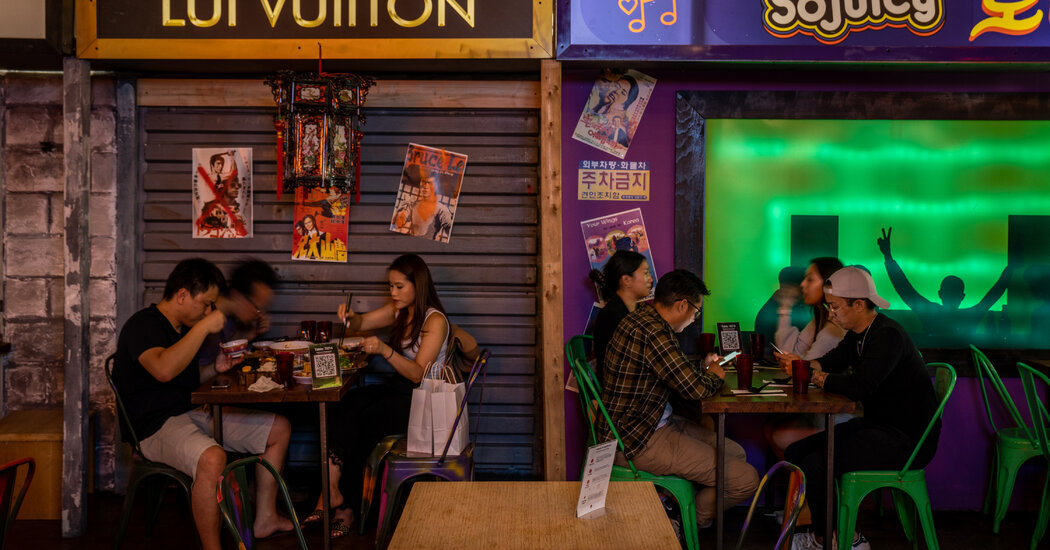
Canada’s biggest city and North America’s fourth-largest metropolis, Toronto received more than 27.5 million visitors annually before the pandemic, making it Canada’s top tourism destination, according to Destination Toronto, the city’s tourism-marketing arm.
As travel rebounds, Canadian tourists are predominating, with traffic from the United States just starting to return and overseas visitors still scant, according to data from the agency. Summer is typically high season; this may be the last year to take advantage of Toronto in warm weather before the city gets swamped again.
More than 5,100 restaurants closed across the province of Ontario during the pandemic, says Restaurants Canada, a national trade organization. But this omnivorous city’s food scene has roared back to life. In May, Michelin chose Toronto as the first Canadian city to get its own guide.
“The vibrancy and diversity is still intact,” said Scott Beck, Destination Toronto’s president and chief executive. “Everything that makes our food scene so unique in North America is still there. The diversity in arts and culture is still there.”
And yes, cannabis stores mushroomed through the pandemic, but “they’re a nonevent,” Mr. Beck said. “Cannabis is legal across the country. Toronto’s not Amsterdam.”
Eating and drinking
The buzziest eateries usually open on Toronto’s bohemian fringes. But alluring restaurants have now sprouted in the downtown core. “The weekend-warrior demand for social dining and entertaining is coming back in a real way,” said Hanif Harji, the chief executive of Scale Hospitality, which operates 14 restaurants. “There’s a buzz on the streets again.”
Mr. Harji’s Bar Chica, open since April, hides behind an unmarked door next to a King Street West condo tower. On a recent Thursday night, the high-ceilinged room throbbed with what felt like pre-Covid energy. The chef Ted Corrado tweaks traditional tapas with Canadian provisions; think British Columbia spot-prawn ceviche, or Canadian-beef chimichurris with Ontario ramps (tapas range from 9 to 24 Canadian dollars, or about $7 to $18). In August Mr. Harji will open Miss Likklemore’s, a Caribbean spot in King West Village. Come fall, Scale and the Montreal chef Antonio Park will open AP, a fine-dining spot atop the Eataly outpost in Yorkville.
Also in Yorkville, the chef Rob Rossi’s Ligurian menu at Osteria Giulia is drawing well-dressed locals who feast on traditional flatbreads, salumi and pastas (entrees from 32 to 75 Canadian dollars). Open since October, it remains the neighborhood’s hottest table. Around the corner, Adrak employs a team of chefs who each specialize in a regional Indian cooking style; the unconventional menu includes smoked salmon with pommery mustard (entrees from 29 to 60 Canadian dollars).
Toronto offers endless options for all kinds of Asian food. A talked-about new spot is Cà Phê Rang, opened south of Chinatown by veterans of the French mainstay Le Select Bistro. A deceptively simple menu yields extravagantly seasoned surprises like halloumi banh mi, shiitake escabeche spring rolls and housemade praline-peanut dipping sauce (entrees from 15 to 20 Canadian dollars).
At Yorkville’s northern edge, Mimi Chinese heads back to the future in a neon-lit room of red velvet banquettes staffed by bow-tied servers. The menu spans Southern China’s provinces, from Guangdong-inspired raw yellowtail kingfish to charred cabbage from Shaanxi. It opened in October, and remains a tough ticket (entrees from 26 to 88 Canadian dollars).
Smorgasburg, the Brooklyn-born open-air food market, will debut its first international edition on Toronto’s waterfront Queen’s Quay on July 23; it runs for eight Saturdays, showcasing local vendors. In the west-side Annex neighborhood, the new Superfresh night market showcases “Asian-led and owned” food and drink vendors in a 4,000-square-foot hall “in the style of an alleyway in Asia,” according to organizers.
With commercial rents soaring, condos sprouting everywhere and space at a premium, nightlife has yet to catch up with food service. “We’re getting a lot of restaurants, which is great. The challenge is finding a place to dance,” said Michael Nyarkoh, the community marketing manager at the new Ace Hotel Toronto.
Back onstage
Closed for renovations three years ago, 127-year-old Massey Hall reopened in November with red velvet seats, splendidly restored stained glass, full accessibility and a crystalline sound system. Its return held special significance for this music-mad city. “Massey Hall was built a year after Carnegie Hall, and the Torontonian dream for a band is to play there,” said Kevin Drew, a founder of the Toronto band Broken Social Scene, which played its first Massey Hall gig in April. The $146 million restoration “did an incredible job of keeping the ghosts and the warmth,” he said. Canadian music royalty from Oscar Peterson to Rush have played the hall, whose packed 2022 slate includes the soul legend Mavis Staples and the alt-country star Orville Peck.
Toronto’s live-theater scene, one of the continent’s largest, is stirring back to life after pandemic closures. For the first time since 2019, the Toronto Fringe Festival, which ends on July 17, has brought back live performances. At the big Broadway-style houses, splashy openings include Harry Potter and the Cursed Child, which opened in May; and Singin’ in the Rain (opens Sept. 23). In February, Hamilton returns. Tickets range from about 99 to 260 Canadian dollars.
On indie stages, intriguing work includes the suburban drama “Detroit” at the east-end Coal Mine Theater (through Aug. 7); the world premiere of Erin Shields’ Shakespeare prequel “Queen Goneril” at Soulpepper (opens Aug. 25); and the Kafka-inspired “Cockroach” at Tarragon (opens Sept. 13). Tickets at these theaters range from 25 to 60 Canadian dollars.
Arts and images
After nearly two years of online shows and stop-start openings, Toronto’s museums have returned with powerhouse lineups. In June, the Art Gallery of Ontario debuted the sweeping exhibition “Faith and Fortune: Art Across the Global Spanish Empire” (through Oct. 10), with 200 works spanning four centuries and three continents. More intimate shows by the Canadian artists Ken Lum and Ed Pien explore personal histories through images and text. A few blocks north, the Royal Ontario Museum opens the Harry Potter-related “Fantastic Beasts: The Wonder of Nature,” exploring what the museum calls “the intersection of natural history and pop culture” (through Jan. 2, 2023).
A few blocks west, the Bata Shoe Museum launches “Future Now: Virtual Sneakers to Cutting-Edge Kicks,” showcasing high-tech designs like Nike’s self-lacing MAGS and a Zaha Hadid/Rem Koolhaas collaboration (through October 2023). The fabulous Gardiner Museum, one of North America’s only museums dedicated to ceramics, is featuring “Sharif Bey: Colonial Ruptures,” with African-inspired icons by the Syracuse-based artist (through Aug. 28). And the four-year-old Museum of Contemporary Art, in a converted west-end car factory, offers two knockout shows: “Land of Dream,” haunting portraits by New York-based Shirin Neshat, and “Summer,” the first solo exhibition by Felix Gonzalez-Torres, a co-founder of the seminal queer collective, General Idea, who died in 1996 (both through July 31).
New hotels by the handful
This is turning out to be a banner year for hotel openings. Canada’s first Ace Hotel will open this summer on a quiet cul-de-sac between busy Queen and King streets. Toronto’s Shim-Sutcliffe Architects have designed a curvy modernist facade whose soaring concrete interiors house Alder, a Mediterranean-inflected restaurant from the Toronto celebrity chef Patrick Kriss (rates from 349 Canadian dollars a night).
With the closing of a huge Hudson’s Bay department store in March, the intersection of Yonge and Bloor streets has felt bleak. The mood should brighten this month with Toronto’s first W Hotel, on the northeast side. Formerly a dour Marriott, the 254-room W tweaks its Brutalist concrete building with riotous color and copious greenery. On tap: An airy street-level cafe, a 5,000-square-foot tapas-and-champagne bar and an enormous rooftop lounge apparently inspired by Yves St. Laurent’s Marrakesh villa (rates from 475 Canadian dollars a night).
The 1 Hotel brand, from the former Starwood chairman Barry Sternlicht, made its Toronto debut last August on the Entertainment District’s western edge. Promising “sustainable luxury” — and boasting 3,000 plants — the 112-room hotel was the only Canadian contender on Condé Nast Traveler’s 2022 Hot List (rates from 530 Canadian dollars a night).
Queen Street West’s 19-room Drake Hotel isn’t exactly new — it opened in 1890, and was refreshed in 2004 — but its 32-room Modern Wing just debuted in a sleek, compact building next door. This is the kind of property with a full-time art curator, color-saturated interiors by the innovative DesignAgency and live music in the basement. Its windowed restaurant offers great sidewalk viewing (rates from 379 Canadian dollars a night).
On the site of the former Pilkington Glass Factory near the Entertainment District, the Robert De Niro-backed Nobu brand will open its first mixed-use development in 2023, with a hotel, 650 residences and a Nobu restaurant. The Toronto architect Stephen Teeple has compared his perforated black building design to a tuning fork.




